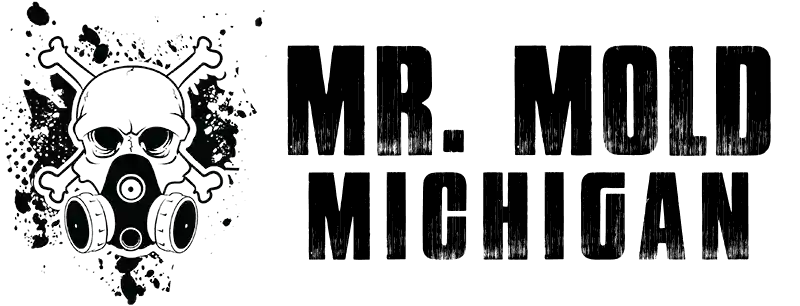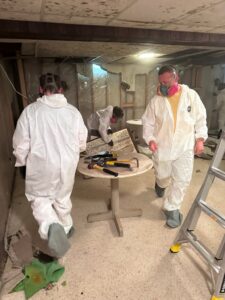The Unseen Foe: What is Mold?
Mold is an insidious type of fungus that finds its home in damp and humid conditions. Unlike plants, molds lack roots, leaves, and other identifiable structures. Instead, they form a network of tiny, thread-like cells called hyphae. When these microscopic fungi discover a nurturing environment, such as a damp surface, they initiate reproduction via minuscule, lightweight spores. These spores can travel through the air, becoming inconspicuous invaders in your home. Their microscopic size and airborne nature allow them to infiltrate your living spaces undetected, setting up colonies wherever conditions are favorable.
Types of Common Indoor Molds
The world of mold is more diverse than you might think. Indoors, you’ll often encounter types such as Cladosporium, Penicillium, Aspergillus, and the notorious black mold, Stachybotrys chartarum. Each of these mold types differs in color, from black and green to white and blue. Cladosporium, often green, brown, or black, commonly invades fabrics and wood surfaces. Penicillium, typically blue or green, loves water-damaged materials. Aspergillus is commonly found in dusty areas or HVAC systems. The black mold, Stachybotrys chartarum, despite its ominous reputation, isn’t always black and often thrives in continually damp, water-soaked materials. The effects of these molds on your health and home can vary, but all should be treated seriously.
Why Should We Worry About Mold?
Mold is not merely an unpleasant sight or nuisance. It’s a silent but relentless destroyer that poses a real threat to both your health and your home. On the health front, it can trigger allergies, cause infections, and even lead to toxic reactions. For individuals with pre-existing respiratory conditions or compromised immune systems, the consequences of exposure can be severe. In terms of your home, mold is a degrader. It decomposes organic materials, leading to damage that goes beyond cosmetic concerns. It can seriously undermine the structural integrity of your home if left to sit.
Dangers of Mold Inside Your Walls
When mold chooses the inside of your walls as its breeding ground, it’s like a ticking time bomb. This enemy operates out of sight, making it even harder to combat. Within these hidden spaces, mold steadily grows, often undisturbed, gradually spreading its hyphae, producing spores, and quietly damaging your home. By the time the mold becomes visible or detectable through other signs, significant damage may have already been done. So, how can we identify these hidden dangers and understand the risks associated with them?
Telltale Signs of Mold in Your Walls
Though mold within walls is elusive, it does leave clues behind. Look out for discolored patches on your walls. Mold colonies can alter the color of your wall surfaces, leaving stains of varying hues. Peeling or bubbling wallpaper is another sign, as the mold’s hyphae can weaken the adhesive, causing the paper to lift. Also, be aware of damp surfaces on your walls or a feeling of moisture when you touch them. This moisture could be due to a hidden water leak—an ideal environment for mold. Finally, don’t underestimate your sense of smell. Mold emits a musty, earthy odor. So, remember, if your home smells off, it’s worth investigating for mold.
The Health Implications
The health implications of mold exposure can be numerous. The most common reactions are allergic symptoms, such as sneezing, runny nose, red eyes, and skin rash. People with mold allergies may have more severe reactions, including shortness of breath. More serious health issues include irritation of the eyes, nose, and throat, triggering coughing and other respiratory symptoms. Extended exposure to certain types of mold can even result in serious conditions such as asthma or, in rare cases, lung infections. Individuals with weakened immune systems, chronic lung diseases, or existing allergies are particularly vulnerable.
Structural Damage
When it comes to your home, mold isn’t merely a cosmetic problem. It can actively eat away the structural materials of your home. When mold colonies take hold in your walls, they begin to decompose the wall materials to fuel their growth. Over time, this can lead to the rotting of wooden structures, weakening of drywalls, and degradation of other construction materials. This damage can compromise the integrity of your house, leading to costly repairs and, in extreme cases, making parts of the building unsafe. Thus, prompt and effective mold remediation is essential to protect both your health and your home.
Why Does Mold Grow in Walls?
Mold’s affinity for walls is a complex interaction of the nature of mold, the properties of walls, and the environmental conditions within your home. Here’s how these factors come together.
The Feast for Fungus: Wall Materials
Walls, particularly those made of organic materials like drywall or wood, present an irresistible feast for molds. These fungi thrive on the cellulose in wood and paper backing of drywall, essentially ‘eating’ the wall material as they grow and spread. So, if you’re wondering why your walls are a prime mold target, it’s primarily due to the delicious dinner they serve up for these microscopic invaders.
Trapping the Moisture: Wall Conditions and Mold Growth
Walls often become unintended moisture traps. This can happen due to several reasons such as condensation, poor ventilation, water leaks, or even high humidity. Condensation can occur when warm, moist air meets a cold surface, causing the moisture in the air to condense on the wall. Similarly, poor ventilation can lead to moisture build-up, particularly in areas such as bathrooms and basements where humidity is usually high. Lastly, walls exposed to leaks—whether from pipes, the roof, or windows—are at risk of becoming damp and, therefore, a potential mold haven.
Molds’ Search for Damp Niche
Molds, being the clever organisms they are, are skilled at finding and exploiting damp areas. With the ability to produce microscopic, airborne spores, molds can easily travel and colonize new areas—like your walls. If the wall is damp and rich in organic material, the mold spores will happily settle, grow, and reproduce.
The Culprits: Water Incursion, Inadequate Airflow, and Excessive Humidity
Ultimately, three main factors make your walls an ideal breeding ground for mold: water incursion, inadequate airflow, and excessive humidity. Water incursion can be due to leaks or flooding, leading to wet walls. Inadequate airflow contributes to moisture build-up and prevents walls from drying properly. Lastly, excessive humidity, especially in poorly ventilated areas or during specific seasons, can cause walls to become damp. All of these conditions provide the perfect environment for mold to flourish.
How to Detect Mold in Walls
Detecting mold in walls can either be a simple do-it-yourself task or require professional assistance, depending on the severity of the infestation. The goal is to spot the mold before it does severe damage or presents a significant health risk.
Do-it-Yourself Methods
Visual inspection and smell are the most straightforward ways to detect mold. As mentioned earlier, look out for discolored patches or a damp, musty smell. However, these methods are only effective when the mold is fairly evident. For a more scientific approach, you can use mold testing kits available in stores or online. These kits usually involve taking a sample from your wall surface, which you then send to a laboratory for analysis.
Professional Inspection
There are times when the severity, invisibility, or potential health risks of a mold infestation warrant professional intervention. A professional mold inspection offers a thorough, accurate, and safe way to tackle mold problems. Let’s delve into the specifics of what this entails.
Why Opt for a Professional Inspection?
Professional mold inspectors have the necessary expertise, experience, and tools to identify and handle mold infestations in a comprehensive and safe manner. They can tackle severe infestations, locate hidden molds, discern different mold types, and suggest the best course of remediation. This is particularly vital when the mold is not easily visible or when the infestation has already spread extensively.
Tools of the Trade
Professional mold inspectors come equipped with a variety of specialized tools that allow for a thorough evaluation of your home. These tools can include moisture meters that measure the moisture level in walls, infrared cameras that can detect temperature differences caused by dampness, and borescopes that allow them to visually inspect hidden areas inside walls or ceilings. Using these advanced tools, professionals can detect mold growth that might otherwise be missed.
Assessing the Extent of Infestation
Another advantage of professional mold inspections is the ability to accurately assess the extent of the mold infestation. Inspectors can ascertain how widespread the mold growth is, how deep it has penetrated into building materials, and how much moisture is contributing to the growth. This assessment is vital for developing an effective remediation plan.
Identifying the Mold Type
Professional mold inspectors are trained to identify different types of mold, each of which may require a different remediation approach. This is important because certain types of mold, such as Stachybotrys chartarum (also known as black mold), can be especially harmful to health and require more rigorous removal methods.
Developing a Remediation Strategy
Following the inspection, a professional will suggest the best remediation strategy based on the type and extent of the mold problem. This strategy could involve simple cleanup procedures, extensive repairs, or, in severe cases, complete renovation of affected areas. They can also suggest ways to address the moisture issues that led to the mold growth, thereby preventing future mold problems.
By choosing a professional mold inspection, you’re investing in the health and safety of your living environment. The knowledge and tools that professionals bring to the table can help ensure that mold is thoroughly eradicated, making your home safer and healthier.
Getting Rid of Mold
Successfully removing mold depends greatly on the size and severity of the infestation. As a rule, small, manageable patches of mold can often be handled by homeowners, while larger infestations require professional intervention.
DIY Mold Remediation
For small areas of mold, a DIY approach can be an efficient and cost-effective solution. This usually involves scrubbing the mold off with household cleaners like bleach or vinegar. Remember, it’s essential to wear proper protective gear, including gloves, goggles, and a mask, during this process. It’s also important to properly dry the area afterward to prevent mold regrowth.
When to Call in Professionals
For larger infestations, especially involving black mold, it’s recommended to call professional mold remediation services. These experts have the tools, knowledge, and protective equipment to safely remove extensive mold growths and clean up after the process, minimizing the risk of recurrence.
Preventing Mold Growth in Walls
Preventing mold is always better than battling it. Some preventive measures include maintaining low humidity in your home, ensuring good ventilation, promptly repairing leaks, and using mold-resistant products like paints and building materials. Regular home inspections can also help catch early signs of mold before it becomes a major issue.



